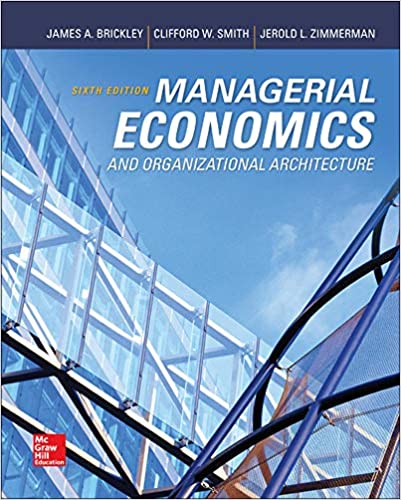
Managerial Economics & Organizational Architecture 6th Edition by James Brickley , Clifford Smith ,Jerold Zimmerman
Edition 6ISBN: 978-0073523149
Managerial Economics & Organizational Architecture 6th Edition by James Brickley , Clifford Smith ,Jerold Zimmerman
Edition 6ISBN: 978-0073523149 Exercise 21
ANALYZING MANAGERIAL DECISIONS: AutoCorp
AutoCorp produces automobiles. It has asked the Amalgamated Fabric Company to consider a proposal to become a supplier of automobile seats. Under the proposal, Amalgamated Fabric would construct a $20 million plant near one of AutoCorp's production facilities. AutoCorp would purchase 100,000 car seats per year at a price of $280 per seat for 15 years-the useful life of the plant. (The actual proposal contains an adjustment for inflation. Ignore this complication in the analysis.)
Amalgamated Fabric's financial analysts have examined the proposal. It appears to be a profitable opportunity. The amortized cost of the plant is $2.6 million per year (at a discount rate of 10 percent). The annual costs are $25.4 million per year. Therefore, the average total cost is $280 per seat-ATC = ($25.4 million + $2.6 million)/100,000 = $280. The financial analysts have examined AutoCorp's financial outlook. Although it has not been highly profitable in all years, there is essentially no probability of bankruptcy over the next 15 years. Since the proposed price covers the cost, the financial analysts think that the proposal should be accepted. (It breaks even with a fair rate of return on invested capital of 10 percent.)
You have been asked to analyze the contract proposal. You have seen the financial analysis and think the cost estimates are reasonable. You are aware that, due to its location, the proposed plant has no alternative use other than supplying seats to AutoCorp. The salvage value of the plant, in the event of liquidation, is $2 million.
What are the costs and benefits of having AutoCorp construct the plant and letting Amalgamated Fabric operate it on a contractual basis
AutoCorp produces automobiles. It has asked the Amalgamated Fabric Company to consider a proposal to become a supplier of automobile seats. Under the proposal, Amalgamated Fabric would construct a $20 million plant near one of AutoCorp's production facilities. AutoCorp would purchase 100,000 car seats per year at a price of $280 per seat for 15 years-the useful life of the plant. (The actual proposal contains an adjustment for inflation. Ignore this complication in the analysis.)
Amalgamated Fabric's financial analysts have examined the proposal. It appears to be a profitable opportunity. The amortized cost of the plant is $2.6 million per year (at a discount rate of 10 percent). The annual costs are $25.4 million per year. Therefore, the average total cost is $280 per seat-ATC = ($25.4 million + $2.6 million)/100,000 = $280. The financial analysts have examined AutoCorp's financial outlook. Although it has not been highly profitable in all years, there is essentially no probability of bankruptcy over the next 15 years. Since the proposed price covers the cost, the financial analysts think that the proposal should be accepted. (It breaks even with a fair rate of return on invested capital of 10 percent.)
You have been asked to analyze the contract proposal. You have seen the financial analysis and think the cost estimates are reasonable. You are aware that, due to its location, the proposed plant has no alternative use other than supplying seats to AutoCorp. The salvage value of the plant, in the event of liquidation, is $2 million.
What are the costs and benefits of having AutoCorp construct the plant and letting Amalgamated Fabric operate it on a contractual basis
Explanation
The input acquiring firm may open its ow...
Managerial Economics & Organizational Architecture 6th Edition by James Brickley , Clifford Smith ,Jerold Zimmerman
Why don’t you like this exercise?
Other Minimum 8 character and maximum 255 character
Character 255


